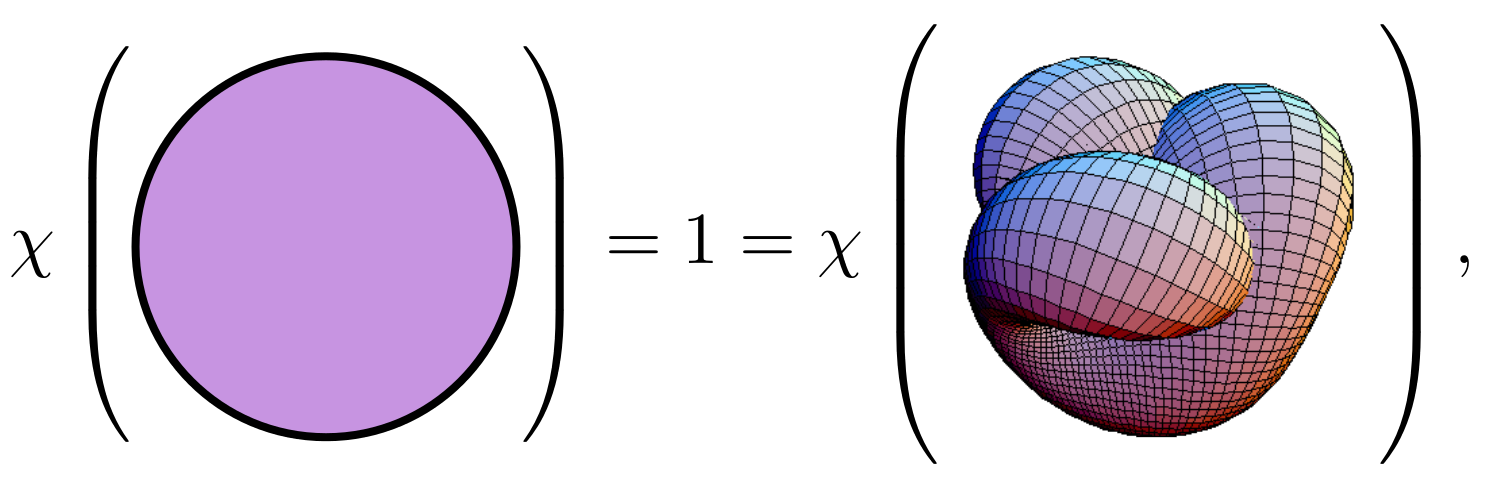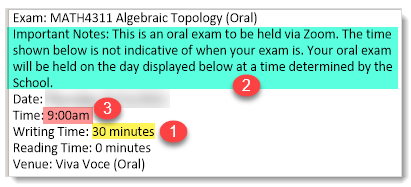“Lecture Algebraic topology”
Algebraic topology is a twentieth century
field of mathematics that is pervasive across mathematics
and the sciences. It is unreasonably successful, being one of
the newest fields of mathematics.
One of the most important aims of algebraic
topology is to distinguish or classify topological
spaces and maps between them up to homeomorphism.
Invariants (data that stays the same under operations
on spaces) and obstructions are
key to achieve this aim, meaning that
\[
\text{invariants different}\Rightarrow\text{spaces different}.
\]
The converse is however often false, and invariants are
stronger the more often the converse holds. However, strong invariants
might but hard or impossible to compute, and
a good invariant is an invariant which balances between
being strong and computable. The main aim of algebraic topology is
to associate algebraic data to topological spaces.
Here is an example. The sphere and the torus illustrated below
are certainly not the same. But how can we be sure? The algebraic
topology approach is to associate to them, say, numbers \(\chi\)


A classical and familiar invariant is
the Euler characteristic of a topological
space (used in the above examples),
which was initially discovered via combinatorial
methods and has been rediscovered
in many different guises. This invariant associates numbers
to topological spaces, and is without doubt a good invariant.
Modern algebraic topology goes one step further, and associates
more sophisticated invariants to topological spaces.
Algebraic topology allows the solution of complicated
geometric problems with algebraic methods.
In a nutshell, imagine a
closed loop of string that looks
knotted in space. How would you tell if you can wiggle
it about to form an unknotted loop
without cutting the string? The space of all deformations
of the loop is an intractable set.
The key idea is to associate algebraic structures, such as
groups or vector spaces, with
topological objects such as knots, in such a way that
complicated topological questions
can be phrased as simpler questions about the algebraic
structures. In particular, this turns
questions about an intractable set into a conceptual or
finite, computational framework
that allows us to answer these questions with certainty.
In this unit you will learn about
fundamental group and covering spaces, homology and
cohomology theory. These form the
basis for applications in other domains within mathematics
and other disciplines, such as
physics or biology. In fact, one of the strengths of algebraic
topology has always been its wide degree of applicability to other fields.
At the end we will have developed skills
to determine whether seemingly
intractable problems can be solved with topological methods.
As a final note, there are three main fields of modern topology,
with a huge overlap, of course. These fields are algebraic,
geometric and differential topology:

Contact
Daniel Tubbenhauer email
Please put [Lecture Algebraic Topology] as the subject.
Who?
-
Fourth semester students in Mathematics interested in a mixture of (linear) algebra, topology
and category theory, but everyone is welcome.
Where and when?
- Time and date for the lecture.
- Every Monday from 12:00-14:00
- Exception: There will be no lecture Monday the 27.Sep.2021; however, we have a lecture (despite being a holiday) Monday the 04.Oct.2021
- Online, zoom links can be found on Canvas. Alternatively use 82018001516
- First lecture: Monday 01.Aug.2021. Last lecture: Monday 01.Nov.2021.
- Time and date for the tutorials.
- Every Friday from 12:00-14:00
- Exception: There will be no tutorial Friday the 01.Oct.2021
- Online, zoom links can be found on Canvas. Alternatively use 81580288984
- First tutorial: Friday 13.Aug.2021. Last lecture: Friday 05.Nov.2021.
- Material for the lecture.
- The main source is Hatcher's book Click
- Prerecorded lectures on the “What is...algebraic topology?” playlist here: Click
- Exercise sheets are available on Canvas Click, or here Click or on this course website.
- Assessments.
- Assignment 1, due 23:59 17.Sep.2021 Click, solutions Click.
- Assignment 2, due 23:59 05.Nov.2021 Click, solutions Click.
- Exam, 24.Nov.2021, start 9:00. Details below.
- Summary: Click
- Mini presentation: Click
- The detailed plan: Click
Schedule
- 09.Aug.2021, Speaker: Daniel Tubbenhauer, Topic: The beginnings - What is...algebraic topology?,
Notes: Click, Video: Click
- 16.Aug.2021, Speaker: Daniel Tubbenhauer, Topic: Some definitions in topology - Cell complexes and alike,
Notes: Click, Video: Click
- 23.Aug.2021, Speaker: Daniel Tubbenhauer, Topic: The fundamental group I - The first steps,
Notes: Click, Video: Click
- 30.Aug.2021, Speaker: Daniel Tubbenhauer, Topic: The fundamental group II - The Seifert-van Kampen theorem,
Notes: Click, Video: Click
- 06.Sep.2021, Speaker: Daniel Tubbenhauer, Topic: The fundamental group III - Covering spaces,
Notes: Click, Video: Click
- 13.Sep.2021, Speaker: Daniel Tubbenhauer, Topic: The fundamental group IV - Groups, graphs and \(K(G,1)\) spaces,
Notes: Click, Video: Click
- 20.Sep.2021, Speaker: Daniel Tubbenhauer, Topic: Homology and cohomology I - Simplicial, singular and cellular homology,
Notes: Click, Video: Click
- 04.Oct.2021, Speaker: Daniel Tubbenhauer, Topic: Homology and cohomology II - The axiomatic approach,
Notes: Click, Video: Click
- 11.Oct.2021, Speaker: Daniel Tubbenhauer, Topic: Homology and cohomology III - Cohomology groups,
Notes: Click, Video: Click
- 18.Oct.2021, Speaker: Daniel Tubbenhauer, Topic: Homology and cohomology IV - The cohomology ring,
Notes: Click, Video: Click
- 25.Oct.2021, Speaker: Daniel Tubbenhauer, Topic: Homology and cohomology V - Poincaré duality,
Notes: Click, Video: Click
- 01.Nov.2021, Speaker: Daniel Tubbenhauer, Topic: Whats next? - Some outlook including homotopy,
Notes: Click, Video: Click
Exercises
The exercises correspond 1:1 to the talks in the list above.
- 09.Aug.2021, Exercise 1, Click
- 16.Aug.2021, Exercise 2, Click
- 23.Aug.2021, Exercise 3, Click
- 30.Aug.2021, Exercise 4, Click
- 06.Sep.2021, Exercise 5, Click
- 13.Sep.2021, Exercise 6, Click
- 20.Sep.2021, Exercise 7, Click
- 04.Oct.2021, Exercise 8, Click
- 11.Oct.2021, Exercise 9, Click
- 18.Oct.2021, Exercise 10, Click
- 25.Oct.2021, Exercise 11, Click
- 01.Nov.2021, Exercise 12, Click
Exam
If you are on Canvas, you should have seen the following notification (see also
Click):

- The above is an old photo I took, where the day of the exam is still disclosed. The day is 24.Nov.2021.
- Allocated 30 minutes per person, see 1 above. This means 20 minutes of questions, and the remaining 10 minutes are meant as
a buffer between the various exams.
- In 2 above it is stressed that the time you see on your personal notification is when the exam session starts on that day,
not when your exam is.
You will receive a personal invitation email/notification in Canvas with your time
and a zoom link due in time (roughly a week before the exam). Please log into zoom 5 minutes before it is
your term - you will be put in a waiting room.
- In 3, ignore the time, see the previous bullet point.
- Unfortunately, there was no option to alter the field names Writing Time and Reading Time, see 1 and below.
The names should be ignored. The 30 minutes are what is explained in the first point.
- The questions will span the three main topics of the lectures: the general setup, the fundamental group and homology.
- You will get the results and feedback via Canvas, hopefully on the day of the exam. (I will wait until everyone is done before
I decide on a grade.) After the exam there is only a short buffer, so please log out right after the exam.
- I will make a recording of the exam, which is not going to get public. (This is to ensure that everything is legit, which is in your favor.)




